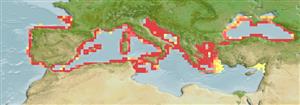>
Callionymiformes (Dragonets) >
Callionymidae (Dragonets)
Etymology: Callionymus: Greek, kallion, comparative of kallos = beautiful + Greek, onyma = name; with a better name.
Environment: milieu / climate zone / intervalo de profundidade / distribution range
Ecologia
marinhas demersal. Subtropical; 46°N - 35°N, 10°W - 42°E
Eastern Atlantic and Mediterranean Sea: Portuguese coast to as far north as Lisbon; also known from the northern Mediterranean including the Adriatic, Aegean and Black seas as well as Lebanon and Israel.
Tamanho / Peso / Idade
Maturidade: Lm ? range ? - ? cm
Max length : 14.0 cm TL macho/indeterminado; (Ref. 5968); 10.0 cm TL (female)
Descrição breve
Chaves de identificação | Morfologia | Morfometria
Espinhos dorsais (total) : 4; Raios dorsais moles (total) : 6 - 7; Raios anais moles: 9.
Body shape (shape guide): elongated.
Inhabits shallow waters with sandy bottoms, occasionally found at a depth of 100 m. Feeds on small bottom invertebrates, mainly worms and crustaceans (Ref. 5968).
Life cycle and mating behavior
Maturidade | Reprodução | Desova | Ovos | Fecundidade | Larvas
Fricke, R., 1986. Callionymidae. p. 1086-1093. In P.J.P. Whitehead, M.-L. Bauchot, J.-C. Hureau, J. Nielsen and E. Tortonese (eds.) Fishes of the North-eastern Atlantic and the Mediterranean. UNESCO, Paris. Vol. 3. (Ref. 5968)
Categoria na Lista Vermelha da IUCN (Ref. 130435: Version 2024-2)
Ameaça para o homem
Harmless
Utilização humana
Ferramentas
Relatórios especiais
Descarregue XML
Fontes da internet
Estimates based on models
Preferred temperature (Ref.
123201): 12.1 - 19.4, mean 17.1 °C (based on 234 cells).
Phylogenetic diversity index (Ref.
82804): PD
50 = 0.5000 [Uniqueness, from 0.5 = low to 2.0 = high].
Bayesian length-weight: a=0.00871 (0.00474 - 0.01602), b=2.70 (2.54 - 2.86), in cm total length, based on LWR estimates for this species & Genus-body shape (Ref.
93245).
Nível Trófico (Ref.
69278): 3.3 ±0.40 se; based on food items.
Resiliência (Ref.
120179): Elevada, tempo mínimo de duplicação da população menor que 15 meses (Preliminary K or Fecundity.).
Fishing Vulnerability (Ref.
59153): Low vulnerability (10 of 100).
🛈
Nutrients (Ref.
124155): Calcium = 115 [26, 356] mg/100g; Iron = 1.35 [0.51, 4.87] mg/100g; Protein = 3.17 [0.00, 6.98] %; Omega3 = 0.328 [0.142, 0.735] g/100g; Selenium = 18.4 [3.6, 55.3] μg/100g; VitaminA = 19.5 [6.1, 59.7] μg/100g; Zinc = 1.04 [0.53, 2.10] mg/100g (wet weight);
